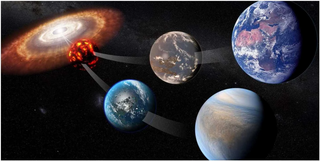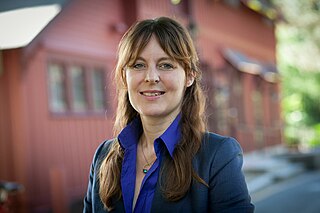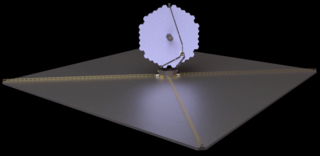Related Research Articles

Astrobiology is a scientific field within the life and environmental sciences that studies the origins, early evolution, distribution, and future of life in the universe by investigating its deterministic conditions and contingent events. As a discipline, astrobiology is founded on the premise that life may exist beyond Earth.

Extraterrestrial life, alien life, or colloquially simply aliens is life which does not originate from Earth. No extraterrestrial life has yet been conclusively detected. Such life might range from simple forms such as prokaryotes to intelligent beings, possibly bringing forth civilizations that might be far more advanced than humanity. The Drake equation speculates about the existence of sapient life elsewhere in the universe. The science of extraterrestrial life is known as astrobiology.

In astronomy and astrobiology, the habitable zone (HZ), or more precisely the circumstellar habitable zone (CHZ), is the range of orbits around a star within which a planetary surface can support liquid water given sufficient atmospheric pressure. The bounds of the HZ are based on Earth's position in the Solar System and the amount of radiant energy it receives from the Sun. Due to the importance of liquid water to Earth's biosphere, the nature of the HZ and the objects within it may be instrumental in determining the scope and distribution of planets capable of supporting Earth-like extraterrestrial life and intelligence.
A biosignature is any substance – such as an element, isotope, molecule, or phenomenon – that provides scientific evidence of past or present life on a planet. Measurable attributes of life include its complex physical or chemical structures, its use of free energy, and the production of biomass and wastes.

Planetary habitability is the measure of a planet's or a natural satellite's potential to develop and maintain environments hospitable to life. Life may be generated directly on a planet or satellite endogenously or be transferred to it from another body, through a hypothetical process known as panspermia. Environments do not need to contain life to be considered habitable nor are accepted habitable zones (HZ) the only areas in which life might arise.

Astrobotany is an applied sub-discipline of botany that is the study of plants in space environments. It is a branch of astrobiology and botany.
Extraterrestrial liquid water is water in its liquid state that naturally occurs outside Earth. It is a subject of wide interest because it is recognized as one of the key prerequisites for life as we know it and is thus surmised to be essential for extraterrestrial life.

An Earth analog, also called an Earth analogue, Earth twin, or second Earth, is a planet or moon with environmental conditions similar to those found on Earth. The term Earth-like planet is also used, but this term may refer to any terrestrial planet.

An exoplanet is a planet located outside the Solar System. The first evidence of an exoplanet was noted as early as 1917, but was not recognized as such until 2016; no planet discovery has yet come from that evidence. What turned out to be the first detection of an exoplanet was published among a list of possible candidates in 1988, though not confirmed until 2003. The first confirmed detection came in 1992, with the discovery of terrestrial-mass planets orbiting the pulsar PSR B1257+12. The first confirmation of an exoplanet orbiting a main-sequence star was made in 1995, when a giant planet was found in a four-day orbit around the nearby star 51 Pegasi. Some exoplanets have been imaged directly by telescopes, but the vast majority have been detected through indirect methods, such as the transit method and the radial-velocity method. As of 1 April 2024, there are 5,653 confirmed exoplanets in 4,161 planetary systems, with 896 systems having more than one planet. This is a list of the most notable discoveries.

Lisa Kaltenegger is an Austrian world-leading astronomer with expertise in the modeling and characterization of exoplanets and the search for life. On July 1, 2014, she was appointed Associate Professor of Astronomy at Cornell University. Previously, she held a joint position at the Max Planck Institute for Astronomy in Heidelberg where she was the Emmy Noether Research Group Leader for the "Super-Earths and Life" group, and at the Center for Astrophysics | Harvard & Smithsonian in Cambridge, MA. She was appointed Lecturer in 2008 at Harvard University and 2011 at University of Heidelberg.

The Nexus for Exoplanet System Science (NExSS) initiative is a National Aeronautics and Space Administration (NASA) virtual institute designed to foster interdisciplinary collaboration in the search for life on exoplanets. Led by the Ames Research Center, the NASA Exoplanet Science Institute, and the Goddard Institute for Space Studies, NExSS will help organize the search for life on exoplanets from participating research teams and acquire new knowledge about exoplanets and extrasolar planetary systems.
The Virtual Planetary Laboratory (VPL) is a virtual institute based at the University of Washington that studies how to detect exoplanetary habitability and their potential biosignatures. First formed in 2001, the VPL is part of the NASA Astrobiology Institute (NAI) and connects more than fifty researchers at twenty institutions together in an interdisciplinary effort. VPL is also part of the Nexus for Exoplanet System Science (NExSS) network, with principal investigator Victoria Meadows leading the NExSS VPL team.

Stephen Kane is a full professor of astronomy and planetary astrophysics at the University of California, Riverside who specializes in exoplanetary science. His work covers a broad range of exoplanet detection methods, including the microlensing, transit, radial velocity, and imaging techniques. He is a leading expert on the topic of planetary habitability and the habitable zone of planetary systems. He has published hundreds of peer reviewed scientific papers and has discovered/co-discovered several hundred planets orbiting other stars. He is a prolific advocate of interdisciplinarity science and studying Venus as an exoplanet analog.

The Large Ultraviolet Optical Infrared Surveyor, commonly known as LUVOIR, is a multi-wavelength space telescope concept being developed by NASA under the leadership of a Science and Technology Definition Team. It is one of four large astrophysics space mission concepts studied in preparation for the National Academy of Sciences 2020 Astronomy and Astrophysics Decadal Survey.

TRAPPIST-1e, also designated as 2MASS J23062928-0502285 e, is a rocky, close-to-Earth-sized exoplanet orbiting within the habitable zone around the ultracool dwarf star TRAPPIST-1, located 40.7 light-years away from Earth in the constellation of Aquarius. Astronomers used the transit method to find the exoplanet, a method that measures the dimming of a star when a planet crosses in front of it.

The Habitable Exoplanet Observatory (HabEx) is a space telescope concept that would be optimized to search for and image Earth-size habitable exoplanets in the habitable zones of their stars, where liquid water can exist. HabEx would aim to understand how common terrestrial worlds beyond the Solar System may be and determine the range of their characteristics. It would be an optical, UV and infrared telescope that would also use spectrographs to study planetary atmospheres and eclipse starlight with either an internal coronagraph or an external starshade.

Teegarden's Star b is an exoplanet found orbiting within the habitable zone of Teegarden's Star, an M-type red dwarf 12.5 light years away from the Solar System. It had the highest Earth Similarity Index (ESI) of any exoplanet, but in February 2024 a new study updated the parameters of the planet, thus reducing its ESI to 0.90, making it no longer the planet with the hightest ESI. Along with Teegarden's Star c, it is among the closest known potentially habitable exoplanets.
Nautilus Deep Space Observatory (NDSO) is a proposed deep space fleet of space telescopes designed to search for biosignatures of life in the atmospheres of exoplanets.
Sarah Rugheimer is a Swiss-American astrobiologist and astrophysicist at Jesus College, Oxford. Her research focuses on the atmospheric composition of exoplanets, and ways of detecting life.

There are several methods currently used by astronomers to detect distant exoplanets from Earth. Theoretically, some of these methods can be used to detect Earth as an exoplanet from distant star systems.
References
- 1 2 3 Cofield, Calla (9 May 2015). "Institute for Pale Blue Dots Renamed to Honor Carl Sagan, Will Search for Alien Life". Space.com. Retrieved 2015-05-11.
- ↑ "About the Carl Sagan Institute" . Retrieved 2021-01-18.
- ↑ Glaser, Linda (January 27, 2015). "Introducing: The Carl Sagan Institute". Archived from the original on 2015-02-27. Retrieved 2015-05-11.
- 1 2 "Carl Sagan Institute - Major Research Areas" . Retrieved 2021-01-18.
- 1 2 3 Cofield, Calla (30 March 2015). "Catalog of Earth Microbes Could Help Find Alien Life". Space.com. Retrieved 2015-05-11.
- ↑ Hegde, Siddharth; Paulino-Lima, Ivan G.; Kent, Ryan; Kaltenegger, Lisa; Rothschild, Lynn (31 March 2015). "Surface biosignatures of exo-Earths: Remote detection of extraterrestrial life". PNAS. 112 (13): 3886–3891. Bibcode:2015PNAS..112.3886H. doi: 10.1073/pnas.1421237112 . PMC 4386386 . PMID 25775594.
- ↑ Cornell University (24 September 2018). "Astronomers use Earth's natural history as guide to spot vegetation on new worlds". Eurekalert! . Retrieved 25 September 2018.
- ↑ Cornell University (13 August 2019). "Fluorescent glow may reveal hidden life in the cosmos". EurekAlert! . Retrieved 13 August 2019.
- ↑ "Biofluorescent Worlds – II. Biological fluorescence induced by stellar UV flares, a new temporal biosignature." Jack T. O'Malley-James1 and Lisa Kaltenegger1, Monthly Notices of the Royal Astronomical Society. Volume 488, Issue 4, October 2019, Pages 4530–4545 doi : 10.1093/mnras/stz1842
- ↑ Linda B. Glaser (25 July 2018). "Exoplanet detectives create catalog of 'light-fingerprints'". Cornell Chronicle . Archived from the original on 27 January 2021. Retrieved 18 January 2021.
- ↑ Blaine Friedlander (24 March 2020). "Earth's own evolution used as guide to hunt exoplanets". Cornell Chronicle . Archived from the original on 1 March 2021. Retrieved 18 January 2021.
